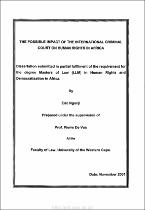| dc.description.abstract | The cruelty and horrors of World War ll were historic in shaping the new world order. The international protection of human rights then gained eminence following the establishment of the Nuremberg and Tokyo international Military Tribunals (lMT) in 1945, to try Nazi and Japanese war leaders for crimes against peace, war crimes, and crimes against humanity committed during the war. Thereafter the United Nations (UN) General Assembly adopted the Convention on the Prevention and Punishment of the Crime of Genocide, (Genocide Convention) on 9 December 1948, and later the Universal Declaration of Human Rights (UDHR) on 10 December 1948. Both
instruments have been pivotal. While the latter has been the foundation upon which all subsequent human rights instruments have been developed, the former expounded the principle of international crimes and extraterritorial jurisdiction. | en_US |

